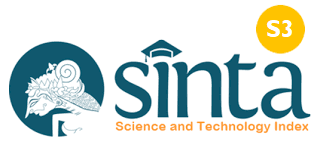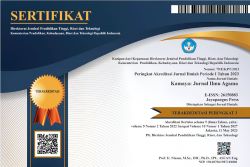Pengelolaan Dana Punia Melalui Pengembangan Pendidikan Pasraman Dan Pemberdayaan Ekonomi Umat di Badan Dharma Dana Punia Raman Utara
DOI:
https://doi.org/10.37329/kamaya.v7i4.3604Keywords:
Dana Punia, Pasraman Education, Economic Empowerment and Dharma Punia AgencyAbstract
Dana punia is a sacred activity as one of the implementations of the teachings of dharma. The purpose of this study is to determine the management system of Punia Funds through the development of pasraman education and empowerment of the people's economy carried out by BDDPRU and to determine the supporting and inhibiting factors for the development of Punia Funds for pasraman education and empowerment of the people's economy carried out by BDDPRU. With that, it will be possible to obtain a maximum fund management system by pasraman. In addition, this study is able to encourage and empower Hindus in the future. This research method is Qualitative and uses studies in accordance with Humanistic theory and the theory of Motivation to do business in the management of Dharma Dana. One of the supporting factors for BDDPRU is the existence of permanent punia funders, this supporting factor can provide a strong solution in the process of managing punia funds through the development of pasraman education and empowerment of the people's economy. One of the inhibiting factors is the lack of adequate facilities and infrastructure. In conclusion, the BDDPRU Punia Fund management system has used POAC (Planning, Organizing, Actuating and Controlling) management but has not been maximized.
References
Arikunto, S. (2005). Prosedur Penelitian: Suatu Pendekatan Praktik. Jakarta: PT Rineka Cipta.
Aulia, H. (2021). Nilai-Nilai Susila Dan Etos Ekonomi Dalam Agama Hindu Studi Kasus Kampung Madras (Doctoral Dissertation, Universitas Islam Negeri Sumatera Utara).
Borg, W. R., & Gall, M. D. (2003). Educational Research: An Introduction (3rd ed.). New York: Longman.
Campbell. (1983). Introduction to Educational Administration. Boston: Allyn and Bacon, Inc.
Fachrudi, I. (1994). Manajemen Pendidikan Global : Visi, Aksi dan Adaptasi. Jakarta : Gaung Persada.
Greenberg & Baron, R. A. (2003). Behavior in Organization: Understanding and Managing the Human Side of Work. New Jersey : Prentice-Hall, inc.
Hasibun. (2009). Manajemen Inovasi : Transformasi Menuju Organisasi Dunia. Bandung : Alfabeta.
Heriyanti, K. (2023). Dana Punia Wujud Integrasi Sosial Umat Hindu. Jnanasiddhanta: Jurnal Teologi Hindu, 4(2), 152-162.
Jones, G. I. (1969). Leadership and Organization. New Jersey : Prentice.
Kajeng, N. (1997). Sarasamuccaya. Surabaya: Paramita.
Maisyarah, M. (2003). Kapita Selekta Manajemen Pendidikan. Bandung : Alfabeta.
Merton, R. (1957). Social Theory and Social Structure, Revised and Enlarged. London: The Free Press of Glencoe.
Puspawidjaja, R. (2006). Hukum Adat Dalam Tebaran Pemikiran. Lampung: Penerbit Universitas Lampung.
Suryanto. (2004). Problematika Penyelenggaraan Pendidikan Berbasis Hindu Di Indonesia: Sebuah Kajian Dari Perspektif Pendidikan Tradisional Model Gurukula di India (Tesis, Universitas Negeri Yogyakarta).
Titib, I M. (2004). Veda Sabda Suci Pedoman Praktis Kehidupan. Surabaya: Paramita.
Downloads
Published
How to Cite
Issue
Section
License
Copyright (c) 2024 Kamaya: Jurnal Ilmu Agama

This work is licensed under a Creative Commons Attribution-ShareAlike 4.0 International License.
An author who publishes in the Kamaya : Jurnal Ilmu Agama agrees to the following terms:
- Author retains the copyright and grants the journal the right of first publication of the work simultaneously licensed under the Creative Commons Attribution-ShareAlike 4.0 License that allows others to share the work with an acknowledgement of the work's authorship and initial publication in this journal
- Author is able to enter into separate, additional contractual arrangements for the non-exclusive distribution of the journal's published version of the work (e.g., post it to an institutional repository or publish it in a book) with the acknowledgement of its initial publication in this journal.
- Author is permitted and encouraged to post his/her work online (e.g., in institutional repositories or on their website) prior to and during the submission process, as it can lead to productive exchanges, as well as earlier and greater citation of the published work (See The Effect of Open Access).
Read more about the Creative Commons Attribution-ShareAlike 4.0 Licence here: https://creativecommons.org/licenses/by-sa/4.0/.





